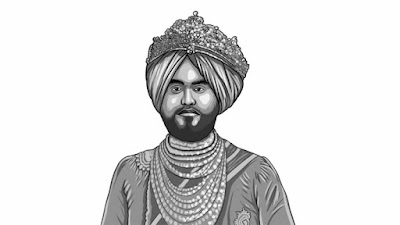 |
| Jagat Seth, the banker of the world, Bengal, 1700s tbsnews.net |
 |
| EIC's victim,Nawab Siraj of Bengal, Nawab Siraj of Bengal, wikipedia |
Robert Clive recaptured the Ft.William with additional army and decided to speed up measures to get rid of Nawab Siraj. Many of the members in the Nawab's council were poorly treated by Siraj who had a bad temper, Clive intelligently used the whistle blowers in the royal court to his advantage. The persistent irksome issues with the ruler led to the Battle of Plassey and this major battle in Bengal saw the downfall of Nawab Siraj who was later killed by his own relative. Thus Mir Jaffer, the head of Nawab's army, who had been demoted by the Nawab became a puppet Nawab.
In the conspiracy initiated by the English company that eliminated Siraj, besides the dissident members, there was yet another unexpected silent partner who had a financial muscle in the Bengal province. Mahtab Rai, also known as Jagat Seth, was a well known financier and banker and no big financial transactions would take place there without his knowledge and help. Being banking and financial wizard, the family of Seth was held in great esteem by the rich people. He came from a rich Marwari Jain business family migrated from Rajasthan to Bengal in the 17th century and his spiritual guru was Jain Acharya Sri Bhratruchandra Suri. The Seths were among the most powerful bankers of India during the first half of 18th century. Roben Orme (official historian of East India Company) described Jagat Seths as 'the greatest shroff (money changer) and banker' in the known world'.
A little known fact about Jagat Seth is his unpalatable and unjust role in the assassination of Nawab Siraj. Jagath Seth, according to some historians, offered a huge sum to the English company for their silent campaign against the rude Nawab. What made Jagat Seth shift his loyalty away from Siraj? One Sudeep Chakravarti, a historian and writer mentioned an incident in which the reputed financier was insulted. by Nawab Siraj, in rage by slapping him for his failure to raise rupees 30 million. Wounded and humiliated, Jagat since that incident had stoically suffered pain and agony. Further, the Seths were in perpetual fear of losing their vast wealth under intemperate Nawab Siraj. In a period of uncertainty, when an opportunity came up from the English company to dethrone Nawab Siraj, Jagat Seth willfully became one of the many conspirators, perhaps to save his banking empire and his status in the society. When many trading issues cropped up with the company, Jagat acted as an intermediary between the ruler and the British and collected a fee from the latter. In the light of the revelation of Nawab Siraj getting in touch with the French at Pondicheery and Chandnagore to drive the British out of Bengal, the company became cautious. Further, their patience reached the fag end over frequent demands of money by Nawab,. The dethronement of the Nawab had become an absolute necessity so that they could put a puppet ruler in charge and would have him bend the laws in their favor. Robert Clive chose an employee William Watts (c. 1722 – 4 August 1764) to make arrangements for getting rid of the ruler. with help from the dissident members in the Nawab's court. Thus the decisive battle of Plassey
 |
| Prime traitor Mir Jaffer, the betrayer of the Nawab, Bengal, wikipedia |
(June 1757) and the subsequent murder of Nawab Siraj on 2 July 1757 when he was at large after the war, had its roots in Murshidabad, the then capital of Bengal where the plot was hatched at the instigation of Clive. It was in that town, Jagat Seth ran the mint. for the Nawab of Bengal.
In the annals of world History and the British empire, the Battle of Plassey (a small village in Bengal) was an important turning point. It marked the fall of the last independent Nawab of Bengal.and the beginning of British East India Company rule over Bengal and later almost entire South Asia.The victorious British never turned back and in the next 200 years they looted India and its resources as much as they could and became a world power.Their monopoly had an impact on the Americas as well. Thus this war acted as a spring board for the company whose revenue vastly improved Britain's economy (the GDP was way below 3 then) and later financed the industrial revolution there.The British empire grew like a big banyan tree with a big canopy cutting across many continents.
 |
| Quote- greed. Pinrest.com |
 |
| Diabolical Lord Robert Clive of East India co en.wikipedia.org. |
But for conspirators and dissident emirs like Mir Jaffer, his son Mir Miron, Mir Kasim, Omi Chand, and ,EIC 's Qasimbazar chief, William Watts and, to some extend, Jagat Seth, Robert Clive would not laid the basic foundation for the British empire on the soil of fertile Bengal. As for Nawab Siraj, his fate was already sealed well in Murshidabad before the war at Plassey. The British, here on had an open range and, with unabated greed, they had begun their land-grabbing spree. As for the future of the Seths, Jagat Seth, Seth Mahtab Rai and his cousin Maharaj Swaroop Chand were captured and shot dead on the orders of Mir Qasim, the new Nawab of Bengal shortly before the Battle of Buxar in 1764. Jagat Seth was considered to be a traitor as he financed the British during the Battle of Plassey which led to the Death Nawab Siraj and the rise of the British power in the Indian subcontinent.
https://tbsnews.net/feature/jagat-seth-bengal-banker-world-41777
https://en.wikipedia.org/wiki/Jagat_Seth
https://murshidabad.net/history/history-topic-jagat-seth.htm









